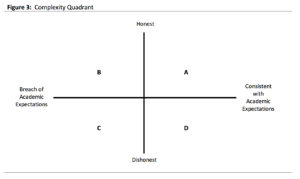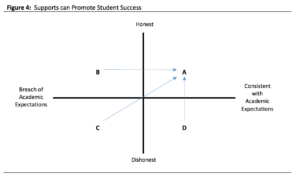The Complexity Quadrant
Daryl Smith; Ragad Anwar; and Vicki Vogel
Academic integrity has traditionally been viewed and evaluated from a binary perspective of honesty versus dishonesty. The Complexity Quadrant framework is offered as an alternative to this binary perspective that better captures the nuances and complexities of the academic integrity issue.
A traditional view is that students in good standing are honest and students who have acted in a manner that is inconsistent with academic integrity policies are dishonest. This binary perspective only considers the observed behaviour and makes assumptions about unobserved intentions (See Figure 1).
We know that there are students in good standing who have acted with intent to deceive (cheated); and there are other students who have not met the expectations of the academic integrity policy, but who have not deliberately acted with an intent to deceive. Even when policies don’t account for intent, recognizing intentionality can shift the conversation to one that encourages learning. Reframing the conversation from punitive measures to student support can lead to student success.

To distinguish between what we can see in a student’s assignment and their intention, we need to separate the observed behaviour from the unobserved intention or motivation; that is, to consider the behaviour without judgement or assumptions about the underlying intention (see Figures 2a & 2b).


Although Figures 2a and 2b separate the observed from the unobserved, it is still an oversimplification of student conduct as it does not consider the relationship between observed behaviours and unobserved intentions.
In order to be more precise in our conversations about student actions, we developed the Complexity Quadrant. The Complexity Quadrant recognizes the connection between observed behaviour and the unobserved intention (see Figure 3). It allows us to engage more precisely with the realities that we see in the classroom and supports the use of preventative assessment design as a tool to encourage student success.

Let us now consider each of these quadrants in turn.
A student in quadrant A has acted in a manner that is consistent with expectations. From their own perspective, they are doing what they believe is ‘right’ or ‘good’. They have no desire to deceive others or manipulate the system to their advantage in a manner that is explicitly or implicitly prohibited or outside the accepted norm in a discipline. Furthermore, from the perspective of an institution, a student who consistently finds themselves in this quadrant will likely be ‘in good standing’, acting in accordance with the established academic policies. Quadrant A is where we want all our students to be.
A student who acts in a manner that is inconsistent with academic conventions or policies might be placed in quadrant B or C. Note in both quadrants, the intention is unobservable. What we may observe, however, is that the student has not met behavioural expectations. For instance, an act of plagiarism or looking at another student’s work during an exam may be observed. However, whether the student intended to deceive cannot be observed. A student would find herself in quadrant B if she did not act with the intention to deceive; whereas a student who intentionally subverted the behavioural or academic expectations would find herself in quadrant C.
Policies are often designed or enforced in a manner consistent with quadrants A and C which is binary (see figures 1 and 2a). Converting the binary into four quadrants compels us to consider the impacts of policies and procedures on students in quadrants B and D. Langara’s policies on academic integrity aspire to recognize this more complex reality. Consider the students in quadrant D. These students are considered ‘in good standing’, however, they have acted in a dishonest manner. This may be the case if a student plagiarizes intentionally, but the infraction goes unnoticed. Similarly, if a student cheats during an exam, but no one notices, they will remain ‘in good standing’ and face no academic ramifications. To prevent students from finding themselves in this category, instructors develop mechanisms and processes to attempt to prevent academic offences. At the end of the day however, quadrant D may still contain students who have learned to manipulate current academic structures to their benefit in a dishonest manner.
Many of us focus too intensively on quadrant C, and overlook our students in quadrant B. The students in this quadrant have every desire to follow the rules and expectations within our institution. Their presence in this quadrant may reflect a lack of knowledge or a lack of skills. Alternatively, it may reflect a misunderstanding of how the rules and expectations at one institution may differ from those at other institutions, or from one department within the same institution. For example, they may submit a paper without following an acceptable citation style in one department that is not the accepted convention in another. They may not be aware that academic integrity policy specifies “misrepresenting one’s contributions to group projects” is considered an academic offence. Whatever the cause, their presence in quadrantB necessarily implies their desire is to be in quadrant A.

The question then becomes, as an institution, how do we facilitate the transition of as many students into quadrant A as possible? (See Figure 4).
This toolkit is designed to provide some suggestions.
With the concept of complexity in mind, the following sections examine strategies on fostering academic integrity in our students.
